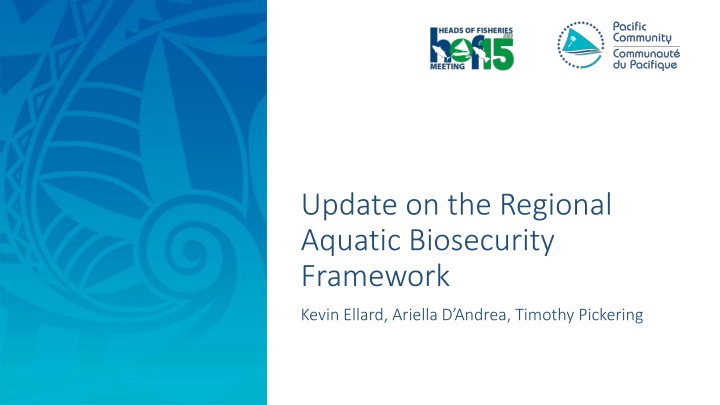
Regional Aquatic Biosecurity Framework Update and Challenges
"Explore the latest updates on the Regional Aquatic Biosecurity Framework by Kevin Ellard, Ariella D'Andrea, and Timothy Pickering. Learn how effective biosecurity measures safeguard the aquatic environment, support local food production, and secure access to export markets. Discover the importance of safeguarding against Stony Coral Tissue Loss Disease and ensuring the health of aquaculture stocks. Dive into strategic documents outlining mid-term reviews, implementation committees, and legislative considerations. Uncover the scope of aquatic animal diseases, safe translocation practices, pest species management, and more. Delve into the challenges faced, from resource limitations to logistical issues, highlighting the need for improved cooperation and diagnostic capacity."
Download Presentation

Please find below an Image/Link to download the presentation.
The content on the website is provided AS IS for your information and personal use only. It may not be sold, licensed, or shared on other websites without obtaining consent from the author. If you encounter any issues during the download, it is possible that the publisher has removed the file from their server.
You are allowed to download the files provided on this website for personal or commercial use, subject to the condition that they are used lawfully. All files are the property of their respective owners.
The content on the website is provided AS IS for your information and personal use only. It may not be sold, licensed, or shared on other websites without obtaining consent from the author.
E N D
Presentation Transcript
Update on the Regional Aquatic Biosecurity Framework Kevin Ellard, Ariella D Andrea, Timothy Pickering
Effective biosecurity assists in safeguarding the aquatic environment, local food production, and access to export markets Needed to increase economic resilience and decrease dependence on food imports.
Safeguarding the aquatic environment Stony Coral Tissue Loss Disease
Safeguarding the aquatic environment Stony Coral Tissue Loss Disease Local food production Ensures prawn aquaculture stocks free of disease, e.g. white spot virus in post-larval prawn imports Feng et. al. 2017
Safeguarding the aquatic environment Stony Coral Tissue Loss Disease Local food production Ensures imported aquaculture stocks free of disease, e.g. white spot virus in post-larval prawn imports Access to export markets Perkinus infection in giant clams for aquarium trade
Strategic documents Mid-term review Establishment of implementation committee Legislative review
Scope? Aquatic animal disease Safe translocation of aquaculture species Aquatic plant disease Pest species Food safety Genetic pollution Horizon scanning
Strategic documents Review national biosecurity plans Establishment of MOU s to assist in inter-agency cooperation Improved diagnostic capacity
Challenges Challenges Lack of technical, human or financial resources Distance and transport logistics Lack of baseline information on and pests and diseases of concern Limited legislative powers or unclear policies Previous lack of inter-agency cooperation and political commitment Diagnostic capacity
Aquatic biosecurity legislation review 1. SPC Aquaculture undertaking a comparative study of national aquatic biosecurity laws and policies. Coastal Fisheries and Programme 2. Twelve Biosecurity Act in place but in most cases there provisions to biosecurity. PICTs already have a are regulate no specific aquatic 3. Requires interagency collaboration between the ministries in charge of agriculture, fisheries, and shipping. environment
Linkages The Council of Regional Organisations in the Pacific (CROP) brings together eight regional inter-governmental agencies. New Zealand Government Australian Government All of you
Thank you Kevin Ellard SPC Aquatic Biosecurity Specialist kevine@spc.int
